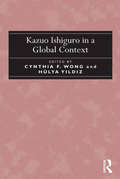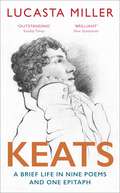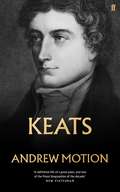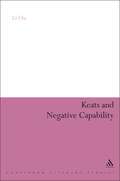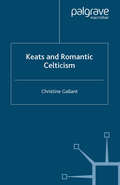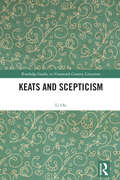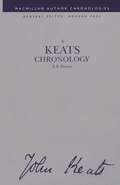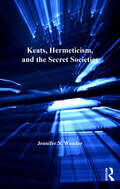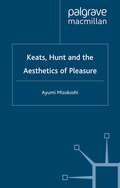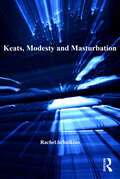- Table View
- List View
Kazuo Ishiguro: Contemporary Critical Perspectives (Contemporary Critical Perspectives)
by Sean Matthews Sebastian GroesKazuo Ishiguro is one of the finest and most accomplished contemporary writers of his generation. The short story author, television writer and novelist, included twice in Granta's list of Best Young British Writers, has over the past twenty-five years produced a body of work which is just as critically-acclaimed as it is popular with the general public. Like the writings of Ian McEwan, Kazuo Ishiguro's work is concerned with creating discursive platforms for issues of class, ethics, ethnicity, nationhood, place, gender and the uses and problems surrounding artistic representation. As a Japanese immigrant who came to Great Britain in 1960, Ishiguro has used his unique position and fine intellectual abilities to contemplate what it means to be British in the contemporary era. This guide traces the main themes throughout Ishiguro's writing whilst it also pays attention to his short stories and writing for television. It includes a new interview with the author, a preface by Haruki Murakami and discussion of James Ivory's adaptation of The Remains of the Day.
Kazuo Ishiguro (Twenty-First Century Perspectives)
by Kristian Shaw Peter SloaneA comprehensive collection of newly commissioned essays from world-leading Kazuo Ishiguro scholars which offers chapters on each of the novels (including the first publication on Klara and the Sun (2021)), short fictions, and screenplays, Kazuo Ishiguro: Twenty First Century Fictions offers a critical reappraisal of the 2017 Nobel Laureate while also uncovering important new thematic and stylistic insights
Kazuo Ishiguro (Twenty-First Century Perspectives)
by Kristian Shaw Peter SloaneA comprehensive collection of newly commissioned essays from world-leading Kazuo Ishiguro scholars which offers chapters on each of the novels (including the first publication on Klara and the Sun (2021)), short fictions, and screenplays, Kazuo Ishiguro: Twenty First Century Fictions offers a critical reappraisal of the 2017 Nobel Laureate while also uncovering important new thematic and stylistic insights
Kazuo Ishiguro in a Global Context
by Cynthia F. Wong Hülya Y?ld?zBringing together an international group of scholars, this collection offers a fresh assessment of Kazuo Ishiguro’s evolving significance as a contemporary world author. The contributors take on a range of the aesthetic and philosophical themes that characterize Ishiguro’s work, including his exploration of the self, family, and community; his narrative constructions of time and space; and his assessments of the continuous and discontinuous forces of history, art, human psychology, and cultural formations. Significantly, the volume attends to Ishiguro’s own self-identification as an international writer who has at times expressed his uneasiness with being grouped together with British novelists of his generation. Taken together, these rich considerations of Ishiguro’s work attest to his stature as a writer who continues to fascinate cultural and textual critics from around the world.
Kazuo Ishiguro in a Global Context
by Cynthia F. Wong Hülya Y?ld?zBringing together an international group of scholars, this collection offers a fresh assessment of Kazuo Ishiguro’s evolving significance as a contemporary world author. The contributors take on a range of the aesthetic and philosophical themes that characterize Ishiguro’s work, including his exploration of the self, family, and community; his narrative constructions of time and space; and his assessments of the continuous and discontinuous forces of history, art, human psychology, and cultural formations. Significantly, the volume attends to Ishiguro’s own self-identification as an international writer who has at times expressed his uneasiness with being grouped together with British novelists of his generation. Taken together, these rich considerations of Ishiguro’s work attest to his stature as a writer who continues to fascinate cultural and textual critics from around the world.
Kazuo Ishiguro’s Gestural Poetics
by Peter SloaneThrough readings of Ishiguro's repurposing of key elements of realism and modernism; his interest in childhood imagination and sketching; interrogation of aesthetics and ethics; his fascination with architecture and the absent home; and his expressionist use of 'imaginary' space and place, Kazuo Ishiguro's Gestural Poetics examines the manner in which Ishiguro's fictions approach, but never quite reveal, the ineffable, inexpressible essence of his narrators' emotionally fraught worlds. Reformulating Martin Heidegger's suggestion that the 'essence of world can only be indicated' as 'the essence of world can only be gestured towards,' Sloane argues that while Ishiguro's novels and short stories are profoundly sensitive to the limitations of literary form, their narrators are, to varying degrees, equally keenly attuned to the failures of language itself. In order to communicate something of the emotional worlds of characters adrift in various uncertainties, while also commenting on the expressive possibilities of fiction and the mimetic arts more widely, Ishiguro appropriates a range of metaphors which enable both author and character to gesture towards the undisclosable essences of fiction and being.
Kazuo Ishiguro’s Gestural Poetics
by Peter SloaneThrough readings of Ishiguro's repurposing of key elements of realism and modernism; his interest in childhood imagination and sketching; interrogation of aesthetics and ethics; his fascination with architecture and the absent home; and his expressionist use of 'imaginary' space and place, Kazuo Ishiguro's Gestural Poetics examines the manner in which Ishiguro's fictions approach, but never quite reveal, the ineffable, inexpressible essence of his narrators' emotionally fraught worlds. Reformulating Martin Heidegger's suggestion that the 'essence of world can only be indicated' as 'the essence of world can only be gestured towards,' Sloane argues that while Ishiguro's novels and short stories are profoundly sensitive to the limitations of literary form, their narrators are, to varying degrees, equally keenly attuned to the failures of language itself. In order to communicate something of the emotional worlds of characters adrift in various uncertainties, while also commenting on the expressive possibilities of fiction and the mimetic arts more widely, Ishiguro appropriates a range of metaphors which enable both author and character to gesture towards the undisclosable essences of fiction and being.
Kazuo Ishiguro's The Remains of the Day: A Reader's Guide (Continuum Contemporaries)
by Adam ParkesContinuum Contemporaries will be a wonderful source of ideas and inspiration for members of book clubs and readings groups, as well as for literature students.The aim of the series is to give readers accessible and informative introductions to 30 of the most popular, most acclaimed, and most influential novels of recent years. A team of contemporary fiction scholars from both sides of the Atlantic has been assembled to provide a thorough and readable analysis of each of the novels in question. The books in the series will all follow the same structure:a biography of the novelist, including other works, influences, and, in some cases, an interview; a full-length study of the novel, drawing out the most important themes and ideas; a summary of how the novel was received upon publication; a summary of how the novel has performed since publication, including film or TV adaptations, literary prizes, etc.; a wide range of suggestions for further reading, including websites and discussion forums; and a list of questions for reading groups to discuss.
Keats: A Brief Life in Nine Poems and One Epitaph
by Lucasta Miller*A BOOK TO LOOK FORWARD TO IN 2021 IN THE TIMES, FINANCIAL TIMES, DAILY MAIL, SUNDAY TIMES AND GUARDIAN*The epitaph John Keats composed for his own gravestone - 'Here lies one whose name was writ in water' - seemingly damned him to oblivion. When he died at the age of twenty-five, having taken a battering from the conservative press, few critics imagined he would be considered one of the great English poets two hundred years later, though he himself had an inkling.In this brief life, Lucasta Miller takes Keats's best-known poems - the ones you are most likely to have read - and excavates their backstories. In doing so, she resurrects the real Keats: a lower-middle-class outsider from a tragic and dysfunctional family, whose extraordinary energy and love of language allowed him to pummel his way into the heart of English literature; a freethinker and a liberal at a time of repression; a human being who delighted in the sensation of the moment; but a complex individual, not the ethereal figure of his posthumous myth.Combining close-up readings of his writings with the story of his brief but teeming existence, Lucasta Miller shows us how Keats made his poetry, and explains why it retains its vertiginous originality and continues to speak to us across the generations.
Keats: Selected By Andrew Motion (Faber Poetry Ser.)
by Sir Andrew MotionKeats is the first major biography of this tragic hero of romanticism for some thirty years, and it differs from its predecessors in important respects. The outline of the story is well known - has become, in fact, the stuff of legend: the archetypal life of the tortured genius, critically spurned and dying young.What Andrew Motion brings to bear on the subject is a deep understanding of how Keats fitted into the intellectual and political life of his time. Important friendships with such anti-establishment figures as William Hazlitt and Leigh Hunt are given their full due, and the closeness of his own spirit, as expressed in his poems, to the ferment all around is made clear. Many significant new facts about Keats's schooldays and medical training, in particular, enrich the picture. Keats emerges as a more political figure than he is usually portrayed, but his personal sufferings, too, come into closer focus. Most importantly, Andrew Motion - himself a distinguished poet and former poet laureate - demonstrates how the poems continue to exert their power. 'A definitive life of a great poet, and one of the finest biographies of the decade.' New Statesman
Keats: The Religious Sense
by Robert M. RyanA landmark account of how Keat&’s religion shaped his life and poetryJohn Keats (1795–1821) was an earnest seeker after truth who believed in the existence of a Supreme Being and felt a need to investigate the consequences and ramifications of that belief. Keats: The Religious Sense reconstructs the historical, social, and intellectual environment that fostered Keats&’s religious convictions and describes the faith he adopted for himself. In this landmark book, Robert Ryan follows Keats&’s religious development through its observable chronological stages, beginning with the process by which he abandoned the Christian faith of his upbringing. Ryan shows how religious speculation and discussion played a significant formative role in the poet&’s intellectual development, especially in the years of his greatest achievement, and argues that Keats&’s critical judgments of Shakespeare, Milton, and Wordsworth—as well as some of his famous theoretical pronouncements on poetry, including his remarks on &“negative capability&” and &“the truth of Imagination&”—cannot be fully understood without understanding the religious context in which they were made.
Keats: The Religious Sense
by Robert M. RyanA landmark account of how Keat&’s religion shaped his life and poetryJohn Keats (1795–1821) was an earnest seeker after truth who believed in the existence of a Supreme Being and felt a need to investigate the consequences and ramifications of that belief. Keats: The Religious Sense reconstructs the historical, social, and intellectual environment that fostered Keats&’s religious convictions and describes the faith he adopted for himself. In this landmark book, Robert Ryan follows Keats&’s religious development through its observable chronological stages, beginning with the process by which he abandoned the Christian faith of his upbringing. Ryan shows how religious speculation and discussion played a significant formative role in the poet&’s intellectual development, especially in the years of his greatest achievement, and argues that Keats&’s critical judgments of Shakespeare, Milton, and Wordsworth—as well as some of his famous theoretical pronouncements on poetry, including his remarks on &“negative capability&” and &“the truth of Imagination&”—cannot be fully understood without understanding the religious context in which they were made.
Keats and Negative Capability (Continuum Literary Studies)
by Li Ou"Negative capability", the term John Keats used only once in a letter to his brothers, is a well-known but surprisingly unexplored concept in literary criticism and aesthetics. This book is the first book-length study of this central concept in seventy years. As well as clarifying the meaning of the term and giving an anatomy of its key components, the book gives a full account of the history of this idea. It traces the narrative of how the phrase first became known and gradually gained currency, and explores its primary sources in earlier writers, principally Shakespeare and William Hazlitt, and its chief Modernist successors, W. B. Yeats and T. S. Eliot. Meanwhile, the term is also applied to Keats's own poetry, which manifests the evolution of the idea in Keats's poetic practice. Many of the comparative readings of the relevant texts, including King Lear, illuminate the interconnections between these major writers. The book is an original and significant piece of scholarship on this celebrated concept.
Keats and Negative Capability (Continuum Literary Studies)
by Li Ou"Negative capability", the term John Keats used only once in a letter to his brothers, is a well-known but surprisingly unexplored concept in literary criticism and aesthetics. This book is the first book-length study of this central concept in seventy years. As well as clarifying the meaning of the term and giving an anatomy of its key components, the book gives a full account of the history of this idea. It traces the narrative of how the phrase first became known and gradually gained currency, and explores its primary sources in earlier writers, principally Shakespeare and William Hazlitt, and its chief Modernist successors, W. B. Yeats and T. S. Eliot. Meanwhile, the term is also applied to Keats's own poetry, which manifests the evolution of the idea in Keats's poetic practice. Many of the comparative readings of the relevant texts, including King Lear, illuminate the interconnections between these major writers. The book is an original and significant piece of scholarship on this celebrated concept.
Keats and Romantic Celticism
by C. GallantThe Celtic Revival began more than a century before Yeats and the Irish Literary Renaissance. Keats and Romantic Celtism is the first book to consider the pervasive influence of period Celticism upon Keats's work, from the Druidism that underlies his unfinished epics to the Celtic-derived folklore that his poetry draws upon. Christine Gallant shows that more than two hundred and fifty traditional folklore motifs of the faerie fill his major poems, as well as minor epistolary ones that have been critically neglected.
Keats and Scepticism (Routledge Studies in Nineteenth Century Literature)
by Li OuKeats and Scepticism explores Keats’s affinity with the philosophical tradition of scepticism and reads Keats’s poetry anew in the light of this affinity. It suggests Keats’s links with the origin of scepticism in ancient Greece as recorded in Sextus Empiricus’s Outlines of Scepticism. It also discusses Keats’s connections with Montaigne, the most important Renaissance inheritor of Pyrrhonian scepticism; Voltaire, the Enlightenment philosophe whose sceptical ideas made an indelible impact on Keats; and Hume, the most thoroughgoing sceptic after antiquity. Other than Keats’s affinitive ideas with these sceptical thinkers, this book is particularly interested in Keats’s experiments with the peculiar language, forms, modes, and genres of poetry to convey the non-dogmatic philosophy. In this light, it re-reads Isabella, ‘La Belle Dame sans Merci’, the 1819 odes, the two Hyperions, King Stephen, and Lamia, all of which reveal Keats’s self-reflexive and radical sceptical poetics in challenging poetic dogmas and conventions. This book is for Keats lovers, students, teachers, scholars, or non-academic readers who are interested in Romanticism, nineteenth-century studies, or poetry and philosophy in general. This original, accessible interdisciplinary study aims to offer the reader a fresh perspective to read Keats and appreciate the quintessential Keatsian poetics.
Keats and Scepticism (Routledge Studies in Nineteenth Century Literature)
by Li OuKeats and Scepticism explores Keats’s affinity with the philosophical tradition of scepticism and reads Keats’s poetry anew in the light of this affinity. It suggests Keats’s links with the origin of scepticism in ancient Greece as recorded in Sextus Empiricus’s Outlines of Scepticism. It also discusses Keats’s connections with Montaigne, the most important Renaissance inheritor of Pyrrhonian scepticism; Voltaire, the Enlightenment philosophe whose sceptical ideas made an indelible impact on Keats; and Hume, the most thoroughgoing sceptic after antiquity. Other than Keats’s affinitive ideas with these sceptical thinkers, this book is particularly interested in Keats’s experiments with the peculiar language, forms, modes, and genres of poetry to convey the non-dogmatic philosophy. In this light, it re-reads Isabella, ‘La Belle Dame sans Merci’, the 1819 odes, the two Hyperions, King Stephen, and Lamia, all of which reveal Keats’s self-reflexive and radical sceptical poetics in challenging poetic dogmas and conventions. This book is for Keats lovers, students, teachers, scholars, or non-academic readers who are interested in Romanticism, nineteenth-century studies, or poetry and philosophy in general. This original, accessible interdisciplinary study aims to offer the reader a fresh perspective to read Keats and appreciate the quintessential Keatsian poetics.
Keats and Shelley: Winds of Light
by Kelvin EverestKeats and Shelley: Winds of Light combines unrivalled textual knowledge, biographical and contextual expertise, and profoundly insightful close readings of the poetry in a selection of outstanding essays from a leading critic of English Romantic Poetry. Some of the essays have been previously published and are established as classic studies, which have strongly influenced scholarly interpretation of the poems they discuss, including landmark readings of Shelley's Prometheus Unbound, 'Julian and Maddalo' and 'Ozymandias', and Keats's 'Isabella: or the Pot of Basil' and his sonnet 'On First Looking into Chapman's Homer'. These are brought into relationship with new work on the two poets, in a wide-ranging set of meditations which centre on Shelley's great elegy for Keats, Adonais. An introductory chapter considers the strongly contrasting poetic styles and achievement of the two iconic 'young Romantics', a contrast which has been obscured by their conventional close pairing in popular culture. Five studies of Keats are followed by a pivotal account of Shelley's elaborately-wrought poetic tribute to Keats's destined greatness, which leads in to a balancing six studies of Shelley. Both poets are situated illuminatingly in their literary, personal, and social-historical milieu, through a series of perspectives which combine lucid particularity with powerful generalization. The essays move from detailed analysis of textual minutiae to deep reflection on fundamental themes in the work of Keats and Shelley, including the ultimate themes of transience and permanence, and of life, death, and immortality.
Keats and Shelley: Winds of Light
by Kelvin EverestKeats and Shelley: Winds of Light combines unrivalled textual knowledge, biographical and contextual expertise, and profoundly insightful close readings of the poetry in a selection of outstanding essays from a leading critic of English Romantic Poetry. Some of the essays have been previously published and are established as classic studies, which have strongly influenced scholarly interpretation of the poems they discuss, including landmark readings of Shelley's Prometheus Unbound, 'Julian and Maddalo' and 'Ozymandias', and Keats's 'Isabella: or the Pot of Basil' and his sonnet 'On First Looking into Chapman's Homer'. These are brought into relationship with new work on the two poets, in a wide-ranging set of meditations which centre on Shelley's great elegy for Keats, Adonais. An introductory chapter considers the strongly contrasting poetic styles and achievement of the two iconic 'young Romantics', a contrast which has been obscured by their conventional close pairing in popular culture. Five studies of Keats are followed by a pivotal account of Shelley's elaborately-wrought poetic tribute to Keats's destined greatness, which leads in to a balancing six studies of Shelley. Both poets are situated illuminatingly in their literary, personal, and social-historical milieu, through a series of perspectives which combine lucid particularity with powerful generalization. The essays move from detailed analysis of textual minutiae to deep reflection on fundamental themes in the work of Keats and Shelley, including the ultimate themes of transience and permanence, and of life, death, and immortality.
Keats as a Reader of Shakespeare
by R. S. WhiteIn this book White "traces the influence of both the comedies and tragedies [of Shakespeare] on Keats's work." Choice
A Keats Chronology (Author Chronologies Series)
by F B PinionThis fully detailed chronology makes the best use of Keats's letters to indicate his poetic aims and achievements. It is supplemented by a valuable introduction and interestingly informative sketches of more than thirty persons of importance in his life. With maps and a bibliography, this work is not only an intensely intimate biography but also an exceptionally useful reference book for students and scholars.
Keats, Hermeticism, and the Secret Societies
by Jennifer N. WunderJennifer Wunder makes a strong case for the importance of hermeticism and the secret societies to an understanding of John Keats's poetry and his speculations about religious and philosophical questions. Although secret societies exercised enormous cultural influence during the late eighteenth and early nineteenth centuries, they have received little attention from Romantic scholars. And yet, information about the societies permeated all aspects of Romantic culture. Groups such as the Rosicrucians and the Freemasons fascinated the reading public, and the market was flooded with articles, pamphlets, and books that discussed the societies's goals and hermetic philosophies, debated their influence, and drew on their mythologies for literary inspiration. Wunder recovers the common knowledge about the societies and offers readers a first look at the role they played in the writings of Romantic authors in general and Keats in particular. She argues that Keats was aware of the information available about the secret societies and employed hermetic terminology and imagery associated with these groups throughout his career. As she traces the influence of these secret societies on Keats's poetry and letters, she offers readers a new perspective not only on Keats's writings but also on scholarship treating his religious and philosophical beliefs. While scholars have tended either to consider Keats's aesthetic and religious speculations on their own terms or to adopt a more historical approach that rejects an emphasis on the spiritual for a materialist interpretation, Wunder offers us a middle way. Restoring Keats to a milieu characterized by simultaneously worldly and mythological propensities, she helps to explain if not fully reconcile the insights of both camps.
Keats, Hermeticism, and the Secret Societies
by Jennifer N. WunderJennifer Wunder makes a strong case for the importance of hermeticism and the secret societies to an understanding of John Keats's poetry and his speculations about religious and philosophical questions. Although secret societies exercised enormous cultural influence during the late eighteenth and early nineteenth centuries, they have received little attention from Romantic scholars. And yet, information about the societies permeated all aspects of Romantic culture. Groups such as the Rosicrucians and the Freemasons fascinated the reading public, and the market was flooded with articles, pamphlets, and books that discussed the societies's goals and hermetic philosophies, debated their influence, and drew on their mythologies for literary inspiration. Wunder recovers the common knowledge about the societies and offers readers a first look at the role they played in the writings of Romantic authors in general and Keats in particular. She argues that Keats was aware of the information available about the secret societies and employed hermetic terminology and imagery associated with these groups throughout his career. As she traces the influence of these secret societies on Keats's poetry and letters, she offers readers a new perspective not only on Keats's writings but also on scholarship treating his religious and philosophical beliefs. While scholars have tended either to consider Keats's aesthetic and religious speculations on their own terms or to adopt a more historical approach that rejects an emphasis on the spiritual for a materialist interpretation, Wunder offers us a middle way. Restoring Keats to a milieu characterized by simultaneously worldly and mythological propensities, she helps to explain if not fully reconcile the insights of both camps.
Keats, Hunt and the Aesthetics of Pleasure (Romanticism in Perspective:Texts, Cultures, Histories)
by Ayumi MizukoshiThis book tackles the age-old interpretative problem of 'pleasure' in Keat's poetry by placing him in the context of the liberal, leisured and luxurious culture of Hunt's circle. Challenging the standard narrative which attribute Keat's astonishing poetic development to his separation from Hunt, the author cogently argues that Keats, profoundly imbued with Hunt's bourgeois ethic and aesthetic, remained a poet of sensuous pleasure through to the end of his short career.
Keats, Modesty and Masturbation
by Rachel SchulkinsExamining John Keats’s reworking of the romance genre, Rachel Schulkins argues that he is responding to and critiquing the ideals of feminine modesty and asexual femininity advocated in the early nineteenth century. Through close readings of Isabella; or the Pot of Basil, The Eve of St. Agnes, Lamia and ’La Belle Dame sans Merci,’ Schulkins offers a re-evaluation of Keats and his poetry designed to demonstrate that Keats’s sexual imagery counters conservative morality by encoding taboo desires and the pleasures of masturbation. In so doing, Keats presents a version of female sexuality that undermines the conventional notion of the asexual female. Schulkins engages with feminist criticism that largely views Keats as a misogynist poet who is threatened by the female’s overwhelming sexual and creative presence. Such criticism, Schulkins shows, tends towards a problematic identification between poet and protagonist, with the text seen as a direct rendering of authorial ideology. Such an interpretation neither distinguishes between author, protagonist, text, social norms and cultural history nor recognises the socio-sexual and political undertones embedded in Keats’s rendering of the female. Ultimately, Schulkins’s book reveals how Keats’s sexual politics and his refutation of the asexual female model fed the design, plot and vocabulary of his romances.


